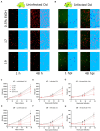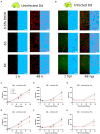Discovery of anti-infective compounds against Mycobacterium marinum after biotransformation of simple natural stilbenes by a fungal secretome
- PMID: 39355425
- PMCID: PMC11443511
- DOI: 10.3389/fmicb.2024.1439814
Discovery of anti-infective compounds against Mycobacterium marinum after biotransformation of simple natural stilbenes by a fungal secretome
Abstract
Introduction: Mycobacterium tuberculosis (Mtb), the causative agent of tuberculosis, remains a serious threat to human health worldwide and the quest for new anti-tubercular drugs is an enduring and demanding journey. Natural products (NPs) have played a significant role in advancing drug therapy of infectious diseases.
Methods: This study evaluated the suitability of a high-throughput infection system composed of the host amoeba Dictyostelium discoideum (Dd) and Mycobacterium marinum (Mm), a close relative of Mtb, to identify anti-infective compounds. Growth of Dd and intracellular Mm were quantified by using luminescence and fluorescence readouts in phenotypic assays. The system was first benchmarked with a set of therapeutic anti-Mtb antibiotics and then used to screen a library of biotransformed stilbenes.
Results: The study confirmed both efficacy of established antibiotics such as rifampicin and bedaquiline, with activities below defined anti-mycobacterium susceptibility breakpoints, and the lack of activity of pyrazinamide against Mm. The screening revealed the promising anti-infective activities of trans-δ-viniferins and in particular of two compounds 17 and 19 with an IC50 of 18.1 μM, 9 μM, respectively. Both compounds had no activity on Mm in broth. Subsequent exploration via halogenation and structure-activity relationship studies led to the identification of derivatives with improved selectivity and potency. The modes of action of the anti-infective compounds may involve inhibition of mycobacterial virulence factors or boosting of host defense.
Discussion: The study highlights the potential of biotransformation and NP-inspired derivatization approaches for drug discovery and underscores the utility of the Dd-Mm infection system in identifying novel anti-infective compounds.
Keywords: Dictyostelium discoideum; Mycobacterium marinum; anti-infectives; natural products; phenotypic screening; stilbene derivatives.
Copyright © 2024 Nitschke, Huber, Vossio, Moreau, Marcourt, Gindro, Queiroz, Soldati and Hanna.
Conflict of interest statement
The authors declare that the research was conducted in the absence of any commercial or financial relationships that could be construed as a potential conflict of interest.
Figures





Similar articles
-
Prioritization of novel anti-infective stilbene derivatives by combining metabolomic data organization and a stringent 3R-infection model in a knowledge graph.RSC Adv. 2025 Apr 23;15(17):13010-13030. doi: 10.1039/d4ra08421g. eCollection 2025 Apr 22. RSC Adv. 2025. PMID: 40271414 Free PMC article.
-
Identification of Anti-Mycobacterium and Anti-Legionella Compounds With Potential Distinctive Structural Scaffolds From an HD-PBL Using Phenotypic Screens in Amoebae Host Models.Front Microbiol. 2020 Feb 21;11:266. doi: 10.3389/fmicb.2020.00266. eCollection 2020. Front Microbiol. 2020. PMID: 32153546 Free PMC article.
-
Temporal genome-wide fitness analysis of Mycobacterium marinum during infection reveals the genetic requirement for virulence and survival in amoebae and microglial cells.mSystems. 2024 Feb 20;9(2):e0132623. doi: 10.1128/msystems.01326-23. Epub 2024 Jan 25. mSystems. 2024. PMID: 38270456 Free PMC article.
-
[Development of antituberculous drugs: current status and future prospects].Kekkaku. 2006 Dec;81(12):753-74. Kekkaku. 2006. PMID: 17240921 Review. Japanese.
-
When Dicty Met Myco, a (Not So) Romantic Story about One Amoeba and Its Intracellular Pathogen.Front Cell Infect Microbiol. 2018 Jan 9;7:529. doi: 10.3389/fcimb.2017.00529. eCollection 2017. Front Cell Infect Microbiol. 2018. PMID: 29376033 Free PMC article. Review.
Cited by
-
Prioritization of novel anti-infective stilbene derivatives by combining metabolomic data organization and a stringent 3R-infection model in a knowledge graph.RSC Adv. 2025 Apr 23;15(17):13010-13030. doi: 10.1039/d4ra08421g. eCollection 2025 Apr 22. RSC Adv. 2025. PMID: 40271414 Free PMC article.
-
Dictyostelium discoideum-Mycobacterium marinum infection model: a powerful high-throughput screening platform for anti-infective compounds.Front Microbiol. 2025 Jul 4;16:1612354. doi: 10.3389/fmicb.2025.1612354. eCollection 2025. Front Microbiol. 2025. PMID: 40687854 Free PMC article.
References
LinkOut - more resources
Full Text Sources
Miscellaneous

